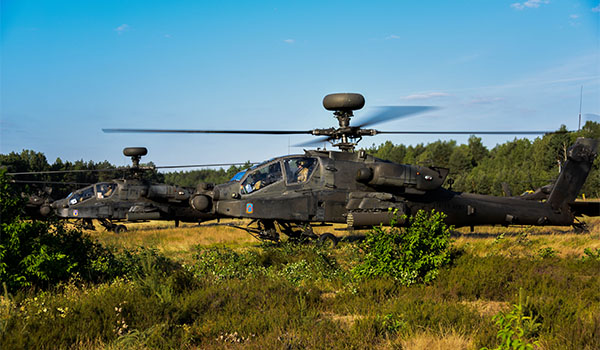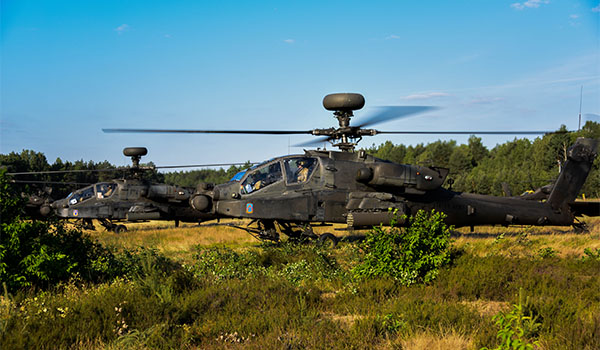
AMCOM Commander Update / By MG Douglas M. Gabram: Twenty-five years ago, I wrote an article in this same publication, ARMY AVIATION magazine, discussing what a lieutenant needs to know to be an effective leader. Hind sight, my experiences since then, and the trends we see daily at AMCOM led me to write an updated version.

U.S. Soldiers with the 12th Combat Aviation Brigade (12 CAB) prepare the AH-64 Apache helicopters for take-off from the Zagan training area, Zagan, Poland, June 21, 2018. The 12 CAB completed the Saber Strike 2018 exercises and is on their way back to U.S. Army Garrison Ansbach, where the Brigade is stationed. / U.S. ARMY PHOTO BY VISUAL INFORMATION SPECIALIST EUGEN WARKENTIN
Part II is an enhanced perspective on Aviation maintenance and sustainment but also focuses on battalion and brigade level leadership. The term “commandments” came from one of my old battalion commanders. You can use rules, laws, policies or guidelines, but commandments always stayed with me more. None of the commandments listed below are new or revolutionary, but after 34 years of experience you may find something that can help you build teams and produce readiness.
Commandment #1: Teamwork is #1. Your effectiveness is directly related to how well you build and sustain trust and relationships. Surround yourself with good people and listen to them. Chief among these key leaders should be talented, operationally-focused maintenance professionals starting with your brigade/battalion aviation maintenance officer (BAMO). You expect a BAMO that you have to hold back, vice push forward. You can go fast by yourself, you can go farther with a great team.
Commandment #2: Maintenance is a green tab responsibility. This is part of being technically and tactically proficient. I used to say understand maintenance – Today, I would say, especially for brigade and battalion level leaders, that you must master maintenance – mission accomplishment depends on mission ready equipment. You have to be able to correlate and connect the dots not only within your own formation but also all the stakeholders who enable your formation.
Commandment #3: Mission Command Maintenance. Effective planning (even if hasty) is critical to succeed in operations and maintenance. Mission-type command orders or P4T3 to plan your maintenance promotes effective communication. Maintenance, while reoccurring, is never just ‘routine’. Execute maintenance by the book – cutting corners here gets people killed. The balance between operations and maintenance is both an art and science, but to get off the ground and accomplish your mission you must do both.
Commandment #4: Report timely and accurately. Know your USR and 1352s cold. You need to understand that the “Army” sees you through readiness reports. Commander’s comments provide an opportunity to describe exactly what you are seeing at the unit level and transmit to echelon. Staffs above the CAB DO read these and can better address fleet trends, training, costs, and sustainment challenges.
Commandment #5: Manage your resources smartly. Understand ASL, PLL, bench stock, and Z-Park accounts – recognize there is an impact on big Army if you don’t — and if you don’t lead in these areas it will impact your fight tonight capability. Army aviation is expensive and generally resourced very well; but you should make sure you are maximizing your buying power at best value for the Army and Nation.
Commandment #6: Good relationships are based on trust. Constantly reassess and look at opportunities to build relationships internal and external to your organization. When things are hard or going bad, positive relationships may win the day. Don’t let a gap develop between you and your boss as it will not just be personal but effect the whole battalion or brigade if you let that relationship go sideways.
Commandment #7: Embrace Change. Our Army is changing at an incredible pace as the threat is changing even faster. It’s a common tendency to keep things the same, especially after a few months into command when you have things the way you want them. Don’t fall into that complacency trap. “If you don’t like change, you will like irrelevancy even less”. Effective leaders LEAD change with vision and persistence.
Commandment #8: Mentor, coach, and teach every day. Develop and execute a leader development (talent management) plan so that they can replace you – because they will one day (faster than you think) and you owe them the best preparation you can give them. A leader who develops others adds; a leader who develops other leaders multiplies.
Commandment #9: CAV-F: Coordinate, Anticipate, Verify and Follow up. Most leaders fail to teach the follow up part of our profession, but it may be the most important action of all. You are responsible to ensure communications are effective and the best way to check is to review what actions occurred based off your guidance.
Commandment #10: Lead by example in all situations possible. Establish from the start that you will do what your Soldiers do, and lead them through it. The better the example the better the leadership. It is sad, but you will see many leaders who cannot or will not take charge. When the weather is bad, the night is long, the work is tough, or life is dangerous you need to BE THERE.
Each commandment has an important role in reminding senior leaders of key aspects in our units, no matter how big or small. We owe it to our Soldiers to stay laser focused and ensure they are ready. You have to be ready to go tonight!
MG Douglas M. Gabram is the commanding general of the U.S. Army Aviation and Missile Life Cycle Management Command at Redstone Arsenal, AL.







